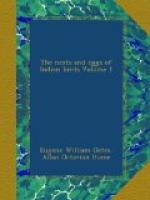531. Sturnus minor, Hume. The Small Indian Starling.
Sturnus minor, Hume; Hume, cat. no. 681 bis.
Mr. Scrope Doig furnishes us with the following interesting note on the breeding of S. minor in Sindh:—
“Last year I mentioned to my friend, Captain Butler, that I had noticed Starlings going in and out of holes in trees along the ‘Narra’ in the month of March, and that I thought they must be breeding there; he said that I must be mistaken, as S. vulgaris never bred so far south. As it happens we were both correct—he in saying S. vulgaris did not breed here, and I in saying that Starlings did. My Starling turns out to be the species originally described from Sindh as Sturnus minor by Mr. Hume; and as I have now sent Mr. Hume a series of skins and eggs, I trust he will give us a note on the subject of our Indian Starlings. In February I shot one of these birds, and on dissection found that they were beginning to breed; later on, early in March, I again dissected one and found that there was no doubt on the subject, and so began to look for their nests; these I found in holes in kundy trees growing along the banks of the Narra, and also situated in the middle of swamps. The eggs were laid on a pad of feathers of Platalea leucorodia and Tantalus leucocephalus, which were breeding on the same trees, the young birds being nearly fledged; the greatest number of eggs in any one nest was five. The first date on which I took eggs was the 13th March, and the last was on the 15th May.
“The eggs are oval, broad at one end and elongated at the other; the texture is rather waxy, with a fine gloss, and they are of a pale delicate sea-green colour.
“The birds during the breeding-time confine themselves closely to their breeding-ground, so much so, that except when close to their haunts none are ever seen.
“The size of the eggs varies from 1.00 to 1.10 in length, and from .70 to .80 in breadth. The average of twelve eggs is 1.03 in length and .79 in breadth.”
He subsequently wrote:—“I first noticed this bird breeding on the 11th March; on the 10th, while marching, I saw some on the side of the road and shot one, and on opening it found it was breeding. Accordingly on the 11th, on searching, I found their breeding-ground, which was in the middle of a Dhund thickly studded over with kundy trees, in the holes of which they had their nests. The nest lay at the bottom of the hole, which was generally some 18 inches deep, and consists of a few bits of coarse sedge-grass and feathers of T. leucocephalus and P. leucorodia (which were breeding close by). Five was the maximum number of eggs, but four was the normal number in each nest.
“I afterwards found these birds breeding in great numbers all along the Eastern Narra wherever there were suitable trees (kundy trees). At the place I first found them in, the young ones are now many of them fledged and flying about, while in other places they are just beginning to lay.




